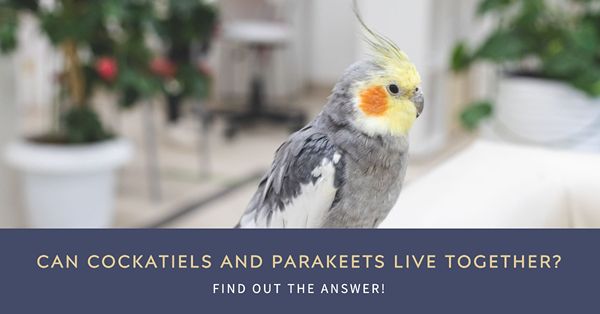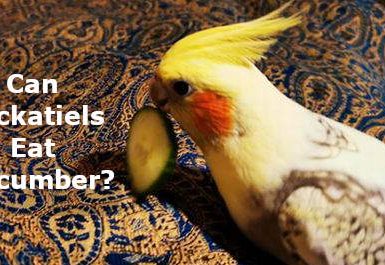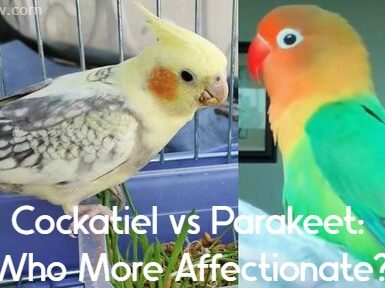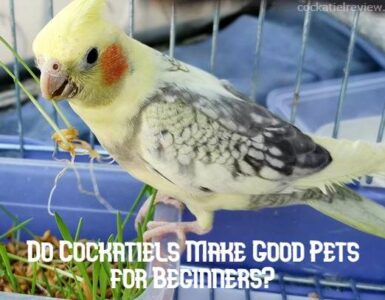
Parrots are one of the most famous companion animals that bring joy and pleasure to their owners. Moreover, they adorn every appearance with their striking appearance and extraordinary behavior. However, before introducing a parrot, one should choose from different breeds.
Coat Cockatiels and Parakeets Can Coexist: Comparability and Details
Cockatiels and parakeets are considered the more common form of parrots, but almost everyone wonders if they will have any chance to exist together? This question must be considered in terms of compatibility and individuality.
In this article we will look at not only how male and female cockatiels can be kept together, but also what issues arise, which criteria to consider, and how to prepare yourself and your boy to live together.
Male and female cockatiel compatibility: the peculiarities of living together
Although cockatiel and parakeets are different birds in appearance, they have every opportunity to exist in the same room. Of course, before challenging the two species together, there are a few things that must be considered.
One of the most important characteristics of cockatiels is their tendency to scream and make noises. If you decide to take a male or female at home, be sure not to receive any complaints from your neighbors. This individuality affects the lives of both roosters and regular parrots.
However, male and female parrots share many common anomalies and habits. They can talk to each other, play together, and even share their food. Corella’s are quite social birds, unlike solitary. Therefore, socializing with other birds can be an extra catalyst for their intensive playing and communication.
However, as with all animals, there will likely be incidents and fights between birds; Corella is more functional and can be cruel, so make sure the structure is sturdy and provides privacy for all birds.
Overall, if you have a large enough building and supervise your boys’ behavior, normal parrots can coexist in a friendly atmosphere. Most importantly, keep in mind that every pattern of bird has its own unique details and consider this the student’s well and prosperity.
Characteristics of Cockatiels and Parakeets
Corella’s:
– Colorful and bright plumage – greenish blue, with a chance to be pink.
– They have a characteristic howl that looks like a resounding flute.
– They are very intelligent and trainable.
– They can be brutal to other birds and will hug their siblings if they do not like the presence of others in the cage.
– They are medium-sized birds, about 30-35 cm long.
Regular Parakeets:
– Characterized by different feathers, often greenish in color with reddish, yellowish, blue or orange components.
– They have a large vocabulary and can repeat and say all kinds of sounds and texts.
– They have an excellent ability to find common language with people and other birds.
– Often brutal, they can be kept alone or in pairs.
– They may well be as small as 40 cm or more, or as small as 20-25 cm.
Description of Cockatiel Appearance and Behavior
Appearance: Cockatiels are small, colorful birds. Their size ranges from 25 to 30 cm. There are a variety of species in this family of birds, but in general they are scar color, blue, greenish, and yellowish.
Behavior: Corella’s are fairly lively and functional birds that are eager to get to know each other and people. They have an active and aggressive behavior, questioning the freedom and space they need to comfort themselves. They can mimic the sounds of play, song, and dance, which makes them very attractive to family breeders.
Details: eagles can be noisy, especially if bored or uninterested. They exhibit territorial behavior, so housing more than one bird at a time without a band is not recommended. They also have a very deep voice, so before you buy a bird you must think about whether the people and animals in your home can stand it.
How parakeets look and behave
Parrots (lat. psittacidae) are a genus of birds in the parrot family. They are diverse in appearance, but what they have in common is a good, crooked beak and long debts.
Appearance depends on the appearance of the parrot. For example, the colors of the Scharlakenrode Springs: reddish, blue, greenish, yellowish, etc. are considered special features. Other species have more subdued and uniform colors. It is important to note that adult birds have more springs than young birds.
Normal parrot behavior remains varied. They have the opportunity to be both measured and very intense. For example, the families of most well-known parrot species, such as the red-tailed Amazon or the talkless dwarf Pulsaway, are social and want to be the center of attention. However, all parrots have inherent behavioral traits that all parrot owners must beautify.
Advantages and Disadvantages of Cockatiels and Regular Parrots Living Together
Advantages:
- Communication. Cockatiels and normal parrots have every opportunity to be very sociable and love to get to know each other; with Buddy-Buddy, they may develop new forms of communication and have fun with Buddy-Buddy.
- Familiarity. As a rule, cockatiels and regular parrots do not compete with each other around land or other means. They can live together and even become friends.
- Personality Development. Parrots learn new behavior and play patterns from each other in order to develop a more convincing personality.
Disadvantages:
- Discouragement. As with all animals, there will be arguments and incidents between them and other parrots. They must be kept under control and not be too intense.
- Welfare. Corellas and parakeets can become ill with various diseases and their health must be monitored and treated if necessary.
- Motivation. If parrots only talk to each other, they have no motivation to learn and train, so you need to give them enough time to communicate and play and organize training and entertainment once a week.
Advantages of keeping male and female cockatiels together
1. A richer life
Corellas and regular cockatoos are quite functional and social birds. Sharing them allows them to get to know each other, play together, and have fun. This is very important to the richness of your family life.
2. demonstration of care
Parrots are quite caring birds and can support their buddy if they are not healthy or have problems. Introducing a cocotte and parrot together can help them take care of each other and create a calmer, more peaceful environment in your home.
3. insensitivity to loneliness
Solitude can have a negative effect on birds, especially if they are used to dealing with people and other birds. Keeping the cockatiel and parakeet together prevents the bird from becoming lonely and certainly helps him become more balanced and peaceful.
4. diversity of behavioral
Because cockatiels and regular parrots have different behavioral traits, they can positively influence each other and learn different types of games and activities.
Drawbacks of sharing a home between cockatiels and regular parrots
- Hostility. Parrots have the opportunity to be brutal in their behavior toward cockatiels, especially when considering national and resource competitors. This can lead to incidents and even attacks between birds.
- All kinds of temperaments and needs. Corellas and ordinary parrots have different habits and needs and can compete for food, water, toys, and other means. They can have different flavors and preferences for food and toys, which can lead to strengths in normal living.
- All kinds of lifestyles. Corellas and normal parrots have different lifestyles. For example, Corellas are more functional and like to fly, while normal parrots spend more time on the floor. This makes one bird more focused than the other and can lead to incidents and intensity among the birds.
How to Ensure Cockatiels and Parakeets Live Comfortably Together
1. cage size and shape
To ensure that male or female falcon parakeets are comfortable together, it is important to ensure that they have adequate space and freedom of movement. The cage should be large enough to allow both birds to fly and play and to entertain with sticks and toys.
2. food menu
Both cockatiels and regular parrots have unique food habits. Every cockatiel should have access to its own primary food species and water as part of its daily diet.
3. individual feed boxes
Individual feed boxes ensure that each bird sees its own feeder and does not compete with others.
4. see and communicate
If your birds do not know each other, it is appropriate to close the two cages close together so that the birds can follow each other from some distance and process initial introductions slowly. Pay attention to body language and sounds and notice how cooperative and happy they are in their surroundings.
5. walk with them
Gradually, after getting to know the birds and anticipating their behavior, you can take them on group walks in non-trivial areas where you can see how they treat each other.
6. place cage.
The location of the cage can also play an important role in developing a comfortable and measured environment for the bird. Make sure the bird has no opportunity to see other pets or pathways. Coated cages are a good choice to dampen sound and ensure privacy for the bird.
How to Keep it Clean?
1. housing location. Parrots need large, comfortably decorated cages with unique spaces for each pattern. For example, extra space can be set aside for waterfowl for cocking, but regular parrots need their own swings and sticks to enjoy themselves.
2. systematic cleaning of the cage. Food and water should be refreshed daily, and the cage lid and floor should be cleaned. For thorough cleaning, the cage should be cleaned with a cleaning agent.
3. use a special cleaning agent. Pet stores can provide special care for their feathered companions. These products help fight scent and kill bacteria.
4. pay attention to your pets. Monitor their lifestyle, energy, well being, and timely marking and eliminating malfunctions. 5.
5. systematic control of the living space and environment. Identify areas where parrots are present in dirt, dust, or debris, ventilate the building regularly, and use an air filter system.
Ways to prevent conflict
1. house birds in different cages
Common cages, while important for stronger consistency among birds, increase the risk of incidents. Therefore, it is possible to keep cockatoos and regular parrots in separate cages. In this way, every bird gets its own space for peace and safety.
2. separation.
Even if the birds live in different cages, it is still a good idea to feed them in different spaces. This way there is no competition for food at all and things become much clearer.
3. give them time alone.
If you have two birds living together, at some point they may take time with the other bird. At those moments, it is advisable to put the birds in separate cages and feed one at a time for a few hours.
4. observe the birds
If you suspect an incident between two birds, separate them immediately. Avoiding injury or unnecessary stress is fundamental and will ensure that all bird wells are not harmed.
Cockatiels vs Parakeets
It has been suggested that cockatiels and parrots can exist next to each other, but only under certain criteria. In general, the comparability of these species is very low, but it is possible, given the oddities
They know each other well. At the first introduction of a cockatiel with a normal parrot, one should observe the behavior with care. It is advisable to keep the cages close together and get to know each other through bars. This will certainly help prevent possible incidents and fights.
Size and structure. Parrots differ in size and behavior. If the birds are slightly different from each other, do not keep the birds in one cage. All animals that have roughly the same size and construction are likely to be better friends.
Food space and quantity. You must ensure that the cage provides enough space where the animals have the opportunity to fly free. Adequate food and water should also be provided so that each student has an important menu.
It is important to consider that every parrot is unique and has the ability to distinguish itself from other parrots. Therefore, follow the animal’s trail and take action in the event of abuse or health problems.
Most important points affecting compatibility
Bird characteristics: One of the most important points of compatibility is bird characteristics. Parrots and cockatoos have unique characteristics in terms of behavior, routines, etc. How they understand each other depends on their personalities. If they are very different, they will not find it together.
Age: Parrots or cockerels of different ages sharing a house can lead to incidents. Young birds have the opportunity to disturb older birds, while adults have the opportunity to show anger toward the young.
Adolescence: Almost all birds exhibit brutal behavior during adolescence. When parrots and cockatoos reach that age, they can be difficult to live with.
Territory: Birds have the opportunity to become territorial. Each of them can apply their own terrain and be inaccessible to other birds. Incidents may occur if one cage shares with a parrot or a cockatiel.
Size: The size of the birds is also useful. Very large differences in volume can lead to incidents. For example, a small cockatoo may suffer from the brutal and rigid sociability of a normal parrot.
Recommendations for choosing an animal not to live
- Select the first type of parrot or parrots that are closest in size and behavior.
- If multiple birds are housed in one cage, the size and number of birds should be considered.
- Avoid different species of birds in the same cage to prevent incidents or specific aggression
- Be aware of bird behavior and separate them if necessary to prevent conflict
- Ensure that every parrot has its own drinking bowl and drinking bowl to avoid competition for food and water
Risks of well
Handover. Conventional parakeets and cockatiels have every opportunity to contract infections of all kinds. They have every chance with food, weightlessness, and all kinds of transfer methods. Some infections can lead to serious illness and even death of the bird.
Stubborn incidents.Corella’s parrots and normal parrots have all kinds of temperaments and relationships can become bold. This can lead to incidents involving ongoing fighting, which can cause injury and stress.
Food Problems. Regular parrots and cholera have different food needs. A table suitable for one species may be harmful to another. Some foods that are harmless to one bird may cause serious health problems in the other.
Differences in housing standards. Each species has its own specific lifestyle and requires its own housing standards. Some birds need more space, others more light and humidity. Poor coordination can negatively affect bird well wells and lead to many diseases and health problems.
Crossing risks. Crossings between cockatiels and native parrots can lead to crazy results and harmful genetic mutations. Offspring may also be uninhabited and sensitive to disease.
Advice on what to do if problems arise while living together
1. do not leave Corellas and parakeets without supervision
If you notice anger or incidents between the birds, do not leave the birds without supervision. If a problem occurs between the birds, one of them should be moved to another aviary or cage to reduce the risk of further incidents 2. allow enough space for the birds
2. give them enough space to live and play
If you want your cockatiels and parakeets to live together, you will want to ensure that there is enough space for all the birds to live and play. All birds should have access to food and water bowls, play toys and space to play.
3. place birds with other birds that have grown and become friends
If you plan to add fresh birds to an existing group, it is recommended that you choose adult birds that are already friends together. Fresh parrots are more likely to adjust and get along with other birds.
4. do not keep birds of different sizes or breeds in the same cage
Different bird races can have different sizes and characteristics and therefore require different situations to live and play. To prevent incidents, it is recommended that you do not keep birds of different breeds and sizes in the same cage.
5. learn more about your bird’s behavior and temperament
Each breed has its own unique personality and structure. The more knowledge the owner has of his birds, the better he can protect them from dangers and incidents. Special websites and forums have information on the behavior and habits of different bird breeds.
Question: Can cockatiels and parrots coexist side by side?
Answer: Yes, they can. However, incidents may occur between species. Make sure the birds are compatible before placing them in the same cage.
Question: What is the difference between Corella and parakeets?
Answer: Corella stand out for their color and are hummingbirds. They have more present sensual agency. Regular parrots are less chatty and less functional.
Q: How do I choose a bird partner?
ANSWER: First, look at the bird’s personality before looking for a partner. Pay attention to the sex, age, and size of the bird to prevent mutual incidents.
Question: What should I do if there is an incident between a cholera and a normal parrot?
ANSWER: Remember to first separate them briefly and then slowly get to know each other under supervision. If the incident persists, especially if the bird is injured, they should be separated forever.
Question: Is it possible to keep cockatiels and regular parrots in the same cage?
Answer: yes, but only if you do not doubt their compatibility with each other and the large dimensions of the cage. However, placing birds in different cages prevents possible incidents and injuries.






Add comment